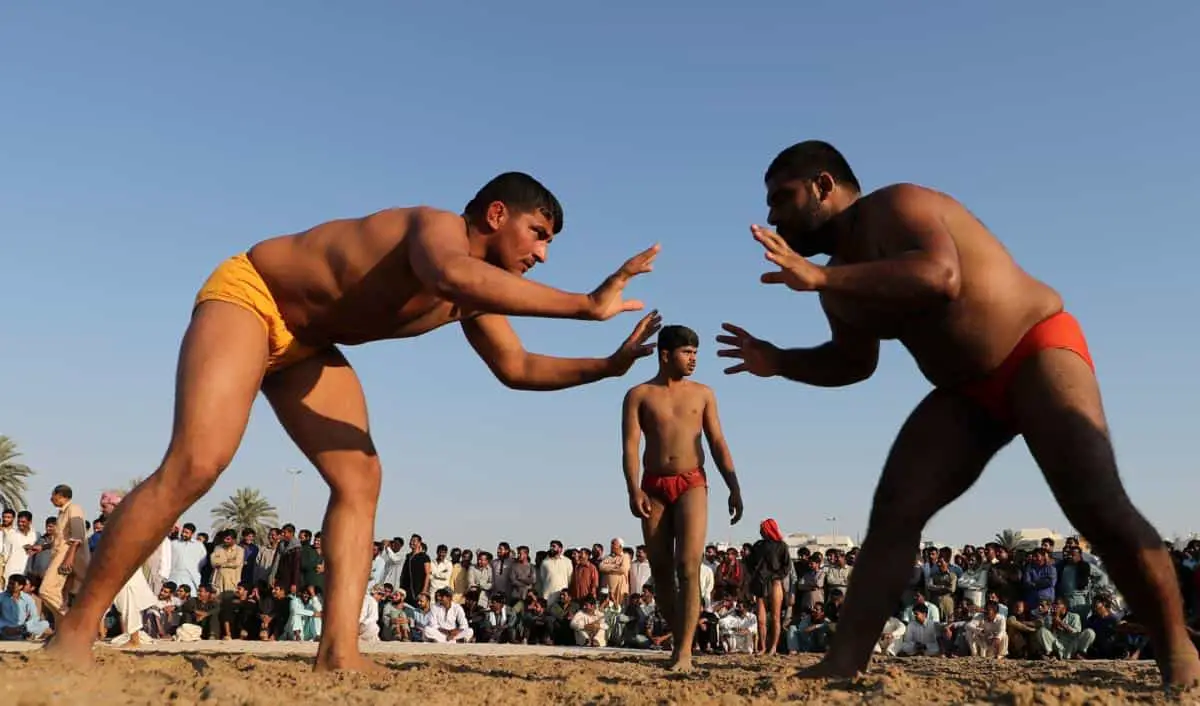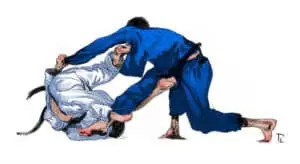Wrestling has been apart of Indian culture since ancient times. There is even a wrestling match described in the Ramayana ( ancient sanskrit text dated to as earyl as 7th century BC). Krishna was said to have defeated the tyrant Kamsa in a wrestling contest to become the new king. Prince Siddhartha Gotama was a high level wrestler before transitioning to philosophy and becoming Buddha. Wrestling has been woven into India’s fabric since its ancient history, however is the sport still popular in India?

Is wrestling popular in India? Yes, wrestling is very popular in India. Thousands of spectators regularly come to watch Kushti mud wrestling contests where athletes can earn as much as 700,000 Indian Rupee ($9500) per tournament. Wrestlers who become champions are held with regard in their village and qualify for well paying government jobs.
Even though Kushti wrestling is still popular in India its popularity has been declining in recent years. The Indian government has reduced its support for Kushti and instead focused more on promoting Olympic wrestling. In the past great Kushti wrestlers were guaranteed cushy government jobs however it is becoming harder and harder to acquire these jobs. The Indian government has instead started reserving these jobs for Olympic wrestlers who win national and international medals.
The Kushti prizes have been in decline as the prize pools are mostly drawn from wealthy villagers who donate. These prizes are often not enough to support the Kushti academies ( known as Akhadas) and the wrestlers. This has led to many young wrestlers being forced to leave the sport to find work that can pay the bills. As the majority of wreslters come from poor rural families they don’t have the luxury of relying on family support to continue their wrestling dreams.
With a lack of wrestlers and income many are Akhadas are closing their doors. This impacts the future of the sport as the next generation of potential wrestlers are unable to train due to lack of training facilities which results in the further decline of the sport.
Kushti wrestlers live an extremely strict and harsh life. Hariom Nuhwar, a Kushti champion describes his typical daily routine. Hariom rises at 4am in the morning and starts his 5 miles run. After finish his run he arrives at the wrestling academy and start preparing the mud pit. Once the mud pit is ready Hariom begins his strength and conditioning which consists of rope climbing, 500 Hindu pushups, mace swings. The training then moves onto drilling wrestling techniques and mock matches with his fellow Kushti wrestlers. After training Hariom goes to work for his daily job and then returns to the Akhada at night for his second round of training.
Here Is What A Typical Kushti Wrestling Training Session Looks Like In An Akhada
In Kushti not only is the training strict but so is the diet. Wrestlers only consume vegetarian food. The wrestlers live with each other in the Akhada and prepare their food together. Hariom will typically eat almonds and other dry fruits, fresh fruits, milk, protein-rich foods, and no oil. Wrestlers consume a huge amount of calorories to fuel their brutal training and to bulk up their muscles.
Hariom says , “the wrestlers follow a Sattvic diet. They believe that non-vegetarian food is only for animals, and by consuming them, the inherent nature of humans becomes equal to those of animals”. Living a righteous, simple and spartan life is an inherent part of Kushti. Wrestlers are expected to be humble and morally upright individuals.
This harsh life is resulting in less new wrestlers training as they can make an easier living pursuing other sports or careers. Freestyle wrestling is often a much better option for many rural poor Indians, as the government is funding the sport (providing salaries and government jobs) and the training is much less intensive than the brutal Kushti regime.
What Are The Rules Of Kushti Wrestling?

What are the rules of Kushti wrestling? Kushti wrestling contests are traditionally no time limit matches which can only be won when one wrestler pins the other. There is no biting, eye gouging or striking. Wrestlers use grappling techniques to take their opponent down and pin them on their back.
Who Are Famous Kushti Wrestlers?

Who are famous Kushti wrestlers? The most famous Kushti wreslter is The Great Gama. The Great Gama was an undefeated mud wrestler who traveled the world defeating European and American champions such as Stanislaus Zbyszko, Jesse Peterson and Benjamin Roller in different styles of wrestling.
Sushil Kumar who won a bronze medal at the 2008 Olympics and a silver medal at 2012 Olympics began his career in Kushti wrestling. Kumar begun training Kushti at an akhada in the Chhatrasal Stadium at the age of 14 before transitioning to freestyle wrestling.
Which State Is Famous For Wrestling In India?

Which state is famous for wrestling in India? Haryana is the state most famous for wrestling in India. Wrestlers from Haryana won 32 out of the 40 medals in men’s freestyle and 19 out of 30 in women’s freestyle at the 2019 Indian national championships. Wrestling is dominated by the Northern Indian states such as Maharashtra, Punjab and Delhi but Haryana is the most famous state.
Haryana is so dominant at wrestling that wrestlers hailing from the northern state which borders Delhi who fail to make the Haryana team are usually more than good enough to become champions of neighboring wrestling hotbeds such as Himachal Pradesh, Delhi and Uttar Pradesh. This is why you will often find Haryana wrestlers representing other states when competing in the national championships.
Why Are Haryana Wrestlers So Successful?
- Competition – Haryana wrestlers compete way more than their rivals, a typical wrestler from Uttar Pradesh may have 6 matches a year, while a wrestler from Haryana will have 60 mat matches alone, excluding mud wrestling matches, Haryana wrestlers regularly compete in front of crowds of thousands of people so when they compete in major tournaments such as the national championships they are prepared
- Rewards – Haryana recruits wrestlers to its police force and offers cash rewards for medalists, approximately 70% of Haryana’s police force are wrestlers, this ensures that participation rates and that many young promising wrestlers continue with the sport, Haryana also recruits wrestlers to other government jobs, in many other Indian states wrestlers do not qualify for government jobs, the fact that wrestlers can be guaranteed with a livable wage and a job from wrestling keeps the sport very popular in Haryana
Conclusion

Wrestling has been a foundational element of Indian society since ancient times. Even Krishna and Buddha were wrestlers. Wrestling continues to be popular in India particularly in the northern states such as Haryana. In recent years in some Indian regions traditional Kushti wrestling has been in decline as the government has stopped providing wrestlers with government jobs. Instead, opting to give these jobs to Olympic wrestlers which has caused many young wrestlers to begin training freestyle.
Kushti wrestling is still strong in Punjab which hosts the highest amount of mud dangals per year. A high level Kushti wrestler can expect to earn up to $10,000 per mud wrestling tournament. Kushti wrestlers can further increase their earnings by receiving donations from wealthy patrons. Kushti wrestling is an important part of Indian culture and the government should do more to sport the ancient sport to ensure it continues to exist.
